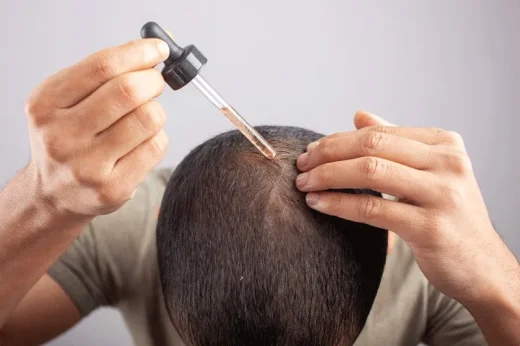Tinea capitis, or hair fungus, is a fungal infection that mostly affects children and it generally exists in the scalp, eyebrows, or eyelashes. It is not common in adults. Microorganisms, such as fungi, are often transmitted from animals. Fungi, from different families, the trichophyton and Microsporum family can often cause this disease. Other types of fungi cause infection. Most of the time, there are one or several rounds, raised, yellowish-crusted, sometimes runny and foul-smelling lesions, soft and tender, a few centimeters wide, on the head. This fungal infection can cause permanent hair loss by destroying the hair follicles. Therefore, early diagnosis and treatment are very important.
What Causes Hair Fungus?
It is mostly transmitted from animals. Those who come into contact with unmaintained stray animals or those who deal with heavy poultry farming are the people most likely to be infected with hair fungus.
Hairdressers, chairs in the cinema and theater hall, bus seats, and gyms with humid environments are unhygienic, and possible for it to be transmitted.
It is found as a carrier in people with a high immune system. For this reason, the use of towels and combs, which are common in the family, can cause the fungus to spread by carrying it.
Fungus formation is mostly observed in the feet and groin areas. Fungi that occur in the foot and groin area can infect the hair and cause the formation of hair fungus.
The main reason for the formation of it is the weakening of the immune system. Improper nutrition, vitamin deficiency, and various diseases can cause a weakening of the immune system.
Types of This Problem
There is also a special type of tinea capitis called favus, which frequently exist in African, Middle Eastern, and Mediterranean countries. In this fungal infection, yellow thick crusts are common on the whole head and cause baldness.
There is another type of hair fungus which is black dot tinea capitis. In this, round or ellipsoidal hair loss occurs only in the affected area. In the affected area, the hair is broken from the root and shed. There are no complaints such as redness, discharge, or swelling in this. Hair fungus itching can be mild or severe. The disease can cause permanent baldness by leaving scars and therefore negatively affects the psychology of children and families.
It is important to examine the family or the child’s classmates or playmates with a dermatologist in terms of hair fungus, as it may transfer in the family or the classroom.
For diagnosis, swabs or scraping material from suspicious lesions needed to examine under a microscope. The diagnosis-confirming way is to see the fungi under the microscope. However, most of the time, this procedure is not necessary for experienced doctors.
Hair Fungus and Hair Loss
Hair fungus occurs with the weakness of the immune system in the body. Fungus is a living microbe and reproduces continuously by spore method. When it is first infected, it damages the scalp and causes hair fungus and dandruff formation, flaking of the skin, and itching. However, if a specialist does not treat hair fungus early, it can cause inflammation in the hair follicles. Inflammation in the hair follicle causes the death of these hair follicles, causing hair loss and no new hair growth on the fungal scalp.

Hair Fungus and Home Remedies
With these cures that you can prepare and apply at home, you will prevent the inflammation that has formed on your scalp, remove the fungi that appear locally, and prevent the formation of new hair fungus.
Hair fungus apple cider vinegar cure: Heat 1 cup of apple cider vinegar. Finely chop some stinging nettle. Throw the nettles you have prepared into the hot apple cider vinegar. Leave the mixture to brew. After the cure you prepared is in the form of brewed, strain it. Wash your hair with this cooling cure. Do not use shampoo to purify your hair from this cure and rinse your hair with cold water.
Hair fungus willow leaf cure: Boil some willow leaves in water for an average of 20 minutes. Strain the willow leaves and leave the juice of the mixture to rest for a day. Rinse your clean hair with this water 3 days a week.
Hair Fungus Treatment
Oral antifungal tablets are important because creams are insufficient in the treatment. Antibacterial antibiotics are often the helpers of the treatment to avoid secondary infection.
Sometimes a short course of steroid therapy is a matter to suppress the inflammation. In addition, suitable hair fungus shampoos are also provided. The duration of treatment is on average 4-6 weeks.
If you have such a problem, you should consult a specialist, as soon as possible. For getting more information you can contact Erdem Clinic.
Frequently Asked Questions
How do you treat hair fungus?
Topical over-the-counter (OTC) medications can be used to treat the majority of scalp yeast infections. These are available as creams, shampoos, or foams. According to research, both allylamines and antifungal medications known as azoles, such as fluconazole (Diflucan), are particularly effective.
What causes fungus in your hair?
Similar to other fungal infections, scalp fungus happens when contagious fungi from other people, animals, or items get onto your scalp and hair. A fungus can be found practically anywhere. A fungus that you come into contact with may spread to your skin and result in an infection.
What does fungus look like in your hair?
When viewed closely, the scalp might seem shiny and scaly with bald spots. If the hair has fallen out directly from the scalp, you can also notice little black specks. The rash known as tinea capitis, or ringworm of the scalp, is brought on by a fungus. On the head, it typically results in bald patches that are itchy and scaly.